 |
|

|
 |
TABLE of CONTENTS
 |
In new campaign, learning about MnDOT only takes a minute |
|
MnDOT kicked off a new video message social media campaign in January called “MnDOT Minutes.” These short, minute-long videos feature different topics about MnDOT’s work during snow and ice to help explain what the agency does and why.
A new video will be released on social media each week through the end of March. The first video, above, is about pretreating. Future video topics include icebreakers, tow plows, storm planning and best advice to drivers.
Look for MnDOT Minute videos on MnDOT’s Facebook, Twitter and Instagram pages.
|
|

|
 |
TABLE of CONTENTS
 |
Working with Tribal Nations to improve places for people to walk |
By Anne Meyer
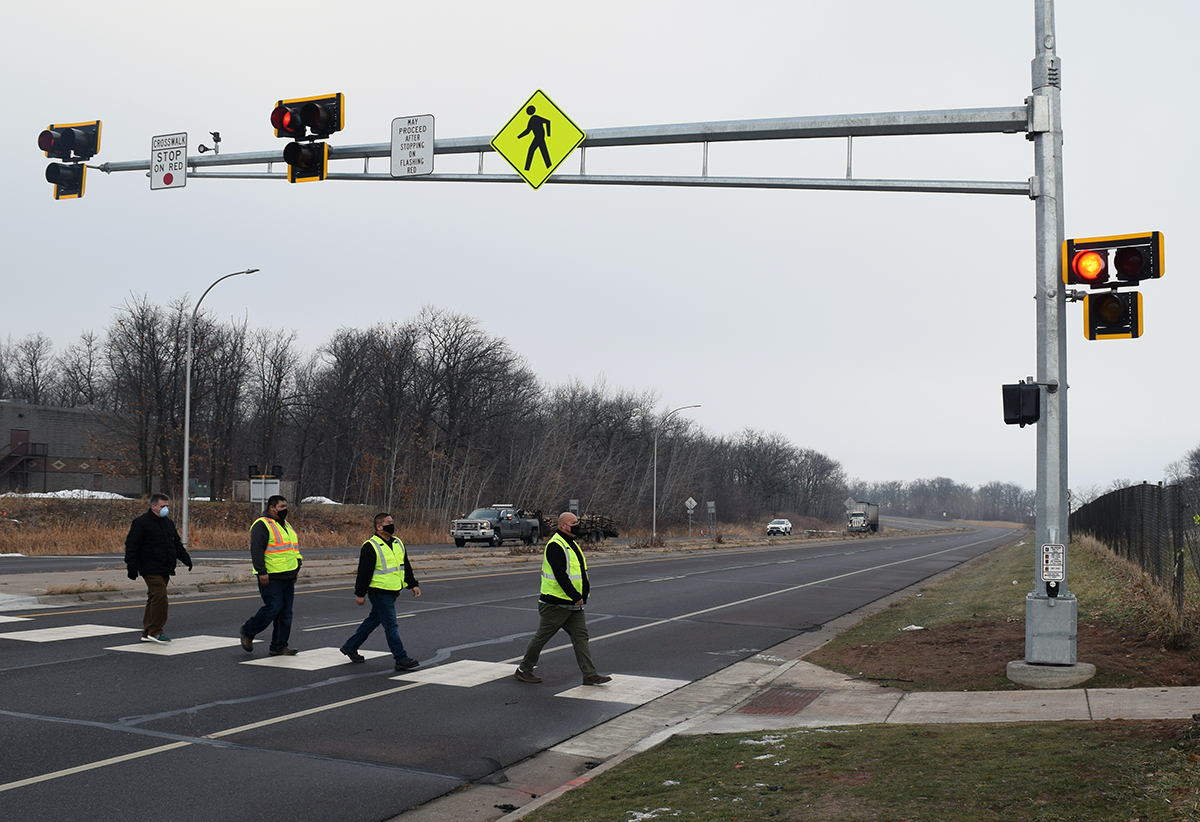
Mille Lacs Band Public Works employees test out new HAWK system intersection on Hwy 169 in Vineland. Photo by Suzy Scotty |
Thanks to a new pedestrian crosswalk signal and growing partnerships with Tribal Nations in Minnesota, it is now safer to walk across the four-lanes of Highway 169 to access schools, government services, the Mille Lacs Indian museum and other community attractions in Vineland.
A HAWK system (short for “high intensity activated cross walk”) was installed north of Ataage Drive late last year and activated in early December. It’s visually unique to help get motorists attention and has proven to be safer and more effective than conventional crosswalk designs.
“Our research found more than 130 people per day were crossing Hwy 169 at this location versus four people per day using a marked crosswalk several blocks away,” said Michael Petesch, pedestrian and bicyclist data coordinator. “This improved crosswalk will better meet the needs of this community and protect people walking.”
This HAWK project was led by the Mille Lacs Band of Ojibwe and is one of several improvement projects planned in Indian Country.
The solutions are the result of a four-year research project involving MnDOT, the University of Minnesota and four Anishinaabe Reservations in Minnesota: the Bois Forte, Fond du Lac, Grand Portage and Mille Lacs bands. The MnDOT Office of Tribal Affairs brought together MnDOT planners and engineers with tribal officials to help identify and address local needs even more.
“Native Americans face increased risks as pedestrians in Minnesota and this coordination with tribal officials provided the necessary knowledge to improve safety,” said Adrien Carretero, Office of Tribal Affairs. “These important partnerships are leading to safety improvements like new lighting, advanced warning signs and improved crosswalks, which we know will help protect lives.”
The next phase of the project is in progress and will identify safety improvements for people walking at sites on at least four additional reservations. Some in-person investigative work has been postponed due to COVID-19. Learn more about this research study and our efforts to strengthen government-to-government relations with Tribal Nations.
|
 |
|

|
 |
TABLE of CONTENTS
 |
COVID-19 resources site updated |
If you haven’t visited it lately, check out MnDOT’s COVID-19 resources site on SharePoint, which has been redesigned to make it easier to find the information you need. Links to the site are also on the iHUB main page.
Latest updates include:
- COVIDaware MN app – The free COVIDaware MN app notifies you if you have been near someone who tests positive for COVID-19. The app will also notify people you have been near if you have a positive COVID-19 test. Your privacy is always protected. No information that will identify you will ever leave your phone. Download the app from the iPhone App Store or the Android Google Play Store.
- Paid COVID-19 leave policy #1440 and Paid COVID-19 Leave/Expanded School Leave Request Form – Minnesota Management & Budget policy revised Jan. 8, 2021. Employees can use paid COVID-19 leave if they must be absent from work for reasons related to COVID-19 and cannot or are not allowed to telework. Certain employees who are assigned to provide critical services may require additional authorization before taking this leave.
- Vaccines – The state is currently in Phase 1a of vaccinations, which include health care workers and assisted-living residents and staff as well as adults 65 years of age or older. State agency employees age 65 and older, along with the general public, can sign up for an appointment at mn.gov/vaccine. There is not enough vaccine for everyone in this category and you may be on a waitlist. MMB sent an email to all state employees with a vaccination update on January 18, and additional information about future phases of vaccinations for state employees will be provided in the weeks ahead as soon as it is available.
The site also provides links to messages from Governor Walz and MnDOT leadership as well as links to additional information about employee assistance, timesheet coding for COVID-19, and the latest guidance from the CDC.
And, finally, a reminder: Always complete the COVID-19 Employee Status and Health Screen Form prior to entering the workplace or when your status changes (e.g., taking sick or vacation leave).
|
| |
|

|
 |
TABLE of CONTENTS
 |
Virtual town hall meetings connect leadership with employees |
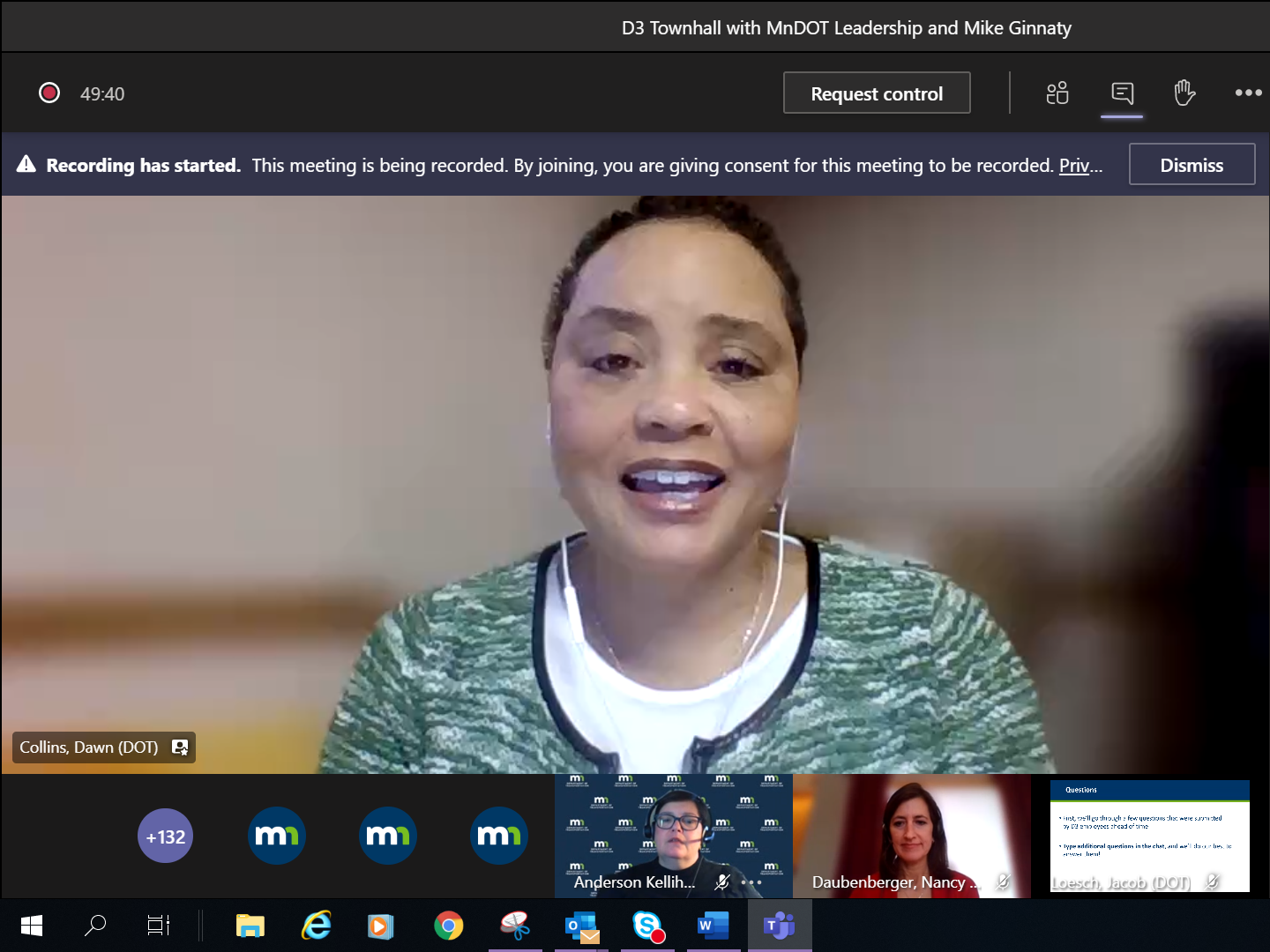
Deputy Commissioner Kim Collins speaks during the District 3 virtual town hall event on Jan. 13. Photo by Chris Joyce. |
Since March 2020, MnDOT has had to adapt in a number of ways to the COVID-19 world that has the majority of our agency continuing to work in the office, field or lab (masked and physically distancing) and about 30 percent of MnDOT employees working from home.
Feeling the need for a more personal connection with employees during this socially distant time, senior leadership has begun hosting a series of virtual town hall events by district to hear from employees and provide them with updates on current issues. The recent implementation of MS Teams in the agency, with its ability to host hundreds of participants in one meeting, provides a broad platform to support this communications effort.
Commissioner Margaret Anderson Kelliher, along with Deputy Commissioners Nancy Daubenberger and Kim Collins, kicked off the first town hall Jan. 7 with District 4 employees and met with District 3 staff Jan. 13. Also headlining the meetings were District 4 Engineer Shiloh Wahl and District 3 Engineer Mike Ginnaty. In addition, Karin van Dyck, Human Resources director, participated in the District 3 town hall to help answer HR-related questions. Between 130-140 employees participated in each event.
“My preference would be to travel to each district and meet with employees in person, but that’s just not an option at the moment,” said Anderson Kelliher. “I was happy to see a strong turnout and engagement from employees so far and look forwarding to continuing these great conversations.”
The town hall general format has the district engineers emceeing the event and providing an overview of district-specific issues before turning it over to the commissioner and deputies to present on current topics, such as the COVID-19 vaccine rollout, budget status, legislative session, and MnDOT’s Strategic Operating Plan. Employees are invited to submit questions in advance or ask them during the meeting.
The following district townhalls are scheduled:
- Thursday, Jan. 21 - District 8
- Friday, Jan. 29 - District 2
- Thursday, Feb. 11 - Metro District
Every district will have a townhall, and meeting notices will go out to employees as soon as their event is scheduled. Dates are not yet confirmed for all districts or for Central Office staff. Plans include scheduling some evening and weekend times for employees not able to the town halls during the day.
|
| |
|

|
 |
TABLE of CONTENTS
 |
New MnDOT Business Manual now on iHub |
By Joseph Palmersheim
A new version of MnDOT’s Business Manual is now available on iHUB.
The Business Manual, last updated in 2017, is a resource for all employees that breaks down state and MnDOT policies into easy-to-understand terms with step-by-step procedures. It covers a variety of topics, including how to get reimbursements for business expenses, how to use purchasing and fuel cards, and how to arrange business-related travel.
The manual, formerly a single PDF document, has been divided into individual sections for quicker access to information. The new design better reflects current processes and ensures that the content aligns with all applicable state policies. The web-based design also is in an ADA-compliant format.
“The [old] manual became inconsistent in format and style as it grew, which made it harder for users to navigate.” said Cori Calhoun, assistant division director, Workforce and Agency Services Division. “The new manual helps users more easily find the information they are seeking. Each section is designed in a more predictable, user-friendly format that includes general information followed by specific procedures. The content was also refreshed with updated policies to ensure the accuracy.”
In addition to a web-based design, the new manual also features a Frequently Asked Questions page, along with a Business Manual comment form. The form goes directly to the manager of the Business Manual for response. Users may also send a message directly to BusinessManual.DOT@state.mn.us.
|
| |
|

|
 |
TABLE of CONTENTS
 |
Statewide Radio, OTAT win 2020 electronic file cleanup contests |
By Charles Stech, Office of Chief Counsel
Two MnDOT offices recently garnered honors for reducing their electronic storage footprint during MnDOT’s most recent Electronic File Cleanup.
The Statewide Radio office deleted 15 percent of its emails and won the Golden Can of Spam, while the Office of Transit and Active Transportation reduced its shared drive storage by nearly 17 percent to win the Golden Hard Drive. The cleanup event ran Nov. 30, 2020, to Jan. 4, 2021.
Golden Can of Spam
The Office of Statewide Radio Communications earned the Golden Can of Spam award by working with MnIT to change the office’s shared drive folder structure, folder naming standards and directory rights. The new drive structure clarifies where the most important documents are stored and reduces duplicate files shared in different folders, said Tim Lee, office director.
Office staff were also encouraged to set aside time to go through files and get rid of unneeded items. Regular office Skype meetings featured discussions where office staff would share things they discovered while cleaning out sent items, junk folders and stored emails.
Lee said he was pleased to hear that the office won, but noted that it might indicate that “we have been saving more emails and documents than we need to.”
“We are hoping to stay more on top of email and file cleanups, so we aren’t the winners next time,” he said.
The Office of Chief Counsel garnered honorable mention for reducing its email storage by 12 percent.
Golden Hard Drive
OTAT created a new Innovation, Data, Evaluation, and Asset Management (IDEA) unit in 2018 to improve data and records management.
“We reviewed the agency’s record retention schedule, sent bi-weekly communication reminders, and identified and reviewed files to be deleted prior to purging them from the network, to ensure retention appropriateness,” said Kirby Becker, IDEA Unit supervisor.
“Our current telework situation provided a nice opportunity to dedicate time without typical distractions that often occur while in the office,” said Tori Nill, OTAT director. “OTAT is very excited to receive this award.”
The Office of Organizational Planning and Management and the State Aid office both earned honorable mentions for each reducing their shared drive storage by more than 11 percent.
Full 2020 cleanup results are available on the Electronic File Cleanup SharePoint site. The next cleanup effort will target shared drive storage and take place in May.
|
| |
|

|
 |
TABLE of CONTENTS
 |
Tips and tricks for using Microsoft Teams |
|
Many of you have already jumped to hosting web meetings, sharing files and creating teams in Microsoft Teams. In the past 60 days, 78 percent of the 5,876 web meetings scheduled at MnDOT took place in Microsoft Teams.
As a reminder, Skype will be decommissioned at the end of this month. Up-to-date information on Teams at MnDOT is available on the Teams MnDOT website. Additional trainings offered by MNIT are also available.
Audio issues
If you ever experience audio problems with Teams when connecting remotely via Citrix web portal, VPN, or other remote network resources, try accessing Microsoft Teams through a web browser. You can log in to Teams.microsoft.com with your state credentials to chat, connect with your Teams, and attend Teams meetings. Connecting to Citrix, VPN or remote connection to your office computer is not necessary before accessing Teams.
File management
While Teams provides space for collaborative work through meetings, chat and document creation, it should not be used for long-term document storage.
Behind every “files” tab in a team is a SharePoint site that allows for collaborative document authoring and editing. Saving files to a team makes it easy for team members and owners to access and share documents. More information on team roles can be found here. Please note: external guests are currently not permitted to join a MnDOT team.
Teams that are inactive for 180 days will automatically be deleted. Team owners will be notified through a series of emails prior any Teams deletion. Resetting inactivity is as easy as sending a chat within a team or loading a new document to the team.
Want to create a team to share and edit files with your colleagues? The Teams request form is the best place to start.
Additional information on file management at MnDOT
Screensharing
Microsoft Teams offers a few different ways to display information in web meetings. Sharing your screen in Teams Meetings and chat starts with the share screen button on the top right corner of your meeting or chat window. When clicked, this button will display a few different options:
- Desktop: Sharing your desktop will essentially share your desktop as you see it. This will include pop-ups or other background content that you have open. This is a good option if you need to share multiple windows or cannot find the window you want to share in window sharing (see below). If you have multiple monitors, ensure you choose the monitor with the content you would like to share.
- Window: Sharing a window will display a single window from an application you have open on your desktop. This can include Word, Excel, a PowerPoint or a web browser. Sharing a window will not share notifications or pop-ups from applications outside of the window you are sharing. To ensure you can display a window, open the window you want to display prior to starting your Team Meeting. Teams will display windows you have open on your desktop for you to choose from.
- PowerPoint: Sharing a PowerPoint allows for a meeting attendee to advance and go back to slides at their own pace. When an attendee changes the slide they are viewing this will not affect the slides displayed to other attendees (each attendee can be viewing a separate slide). The sharing tray in Teams will allow you to choose from a PowerPoint file if the file is open before the Teams meeting starts. If you do not see your presentation, try using a Window or Desktop share.
- Include Computer Sound: Ensure this toggle is “on” if you are seeking to display a video with sound. Note: the desktop Teams application is required to share computer sound.
This article was written by Evan Iacoboni, Matthew Baszner, Nkauj Her, Bobby Underhill and Susan Ogbemudia.
|
| |
|

|
 |
TABLE of CONTENTS
 |
Fireside chat event draws more than 260 attendees |
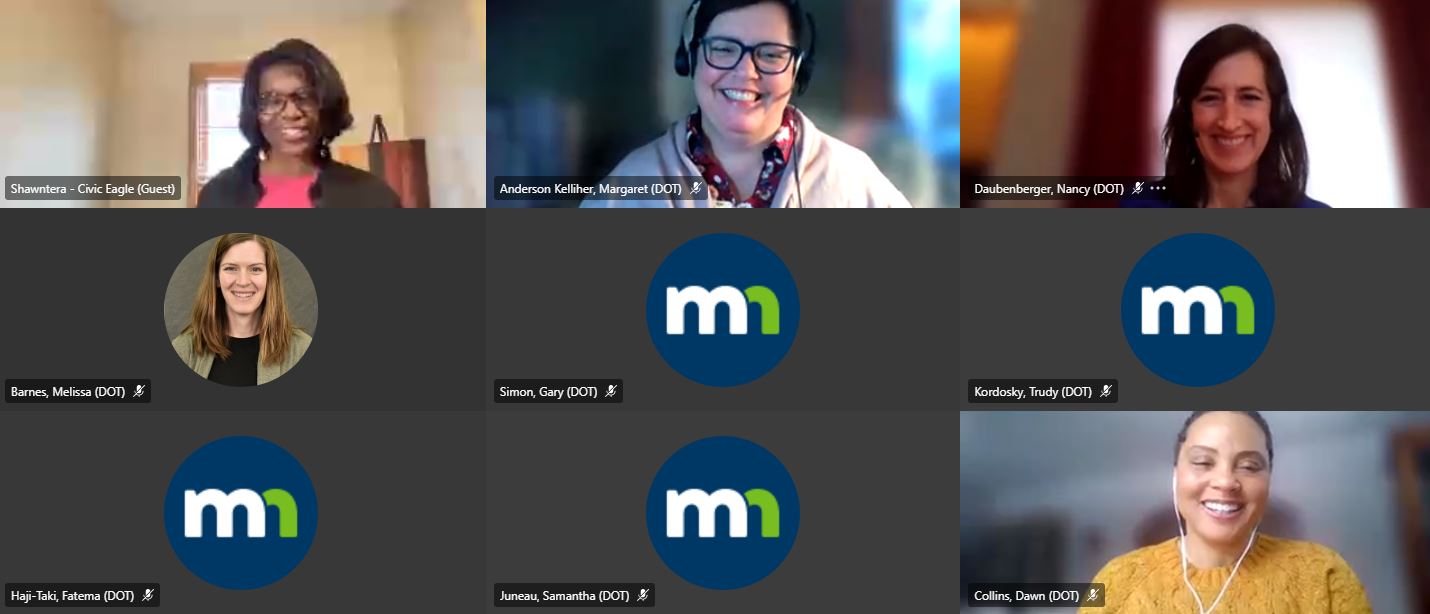
Commissioner Margaret Anderson Kelliher and Deputy Commissioners Nancy Daubenberger and Kim Collins, pictured along with Fireside Chat moderator Shawntera Hardy and attendees participating in the virtual event. Photo by Joseph Palmersheim |
By Joseph Palmersheim
More than 260 MnDOT staff members attended an hour-long online “fireside chat” event Friday, Jan. 15.
The panel discussion with Commissioner Margaret Anderson Kelliher and Deputy Commissioners Nancy Daubenberger and Kim Collins covered gender diversity and equity, their thoughts on overcoming barriers, their vision for the future of transportation, and providing equity and empathy into leadership roles at the agency.
Shawntera Hardy, co-founder and chief of strategy for Civic Eagle, a national consulting firm, served as the host for the event.
A recording of the Fireside Chat is available here.
|
| |
|

|
 |
TABLE of CONTENTS
 |
On the Job: Laura Roads has front-row seat to legislative process |
By Joseph Palmersheim
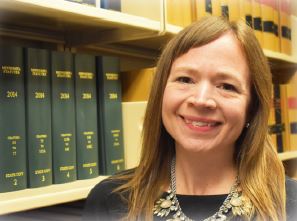
Laura Roads. Submitted photo |
Laura Roads, staff attorney from the Office of Freight and Commercial Vehicles, will return for the 2021 Legislative session in the State Legislative Mobility position. The eight-year MnDOT employee said the 2020 session was “definitely the most unusual one I’ve experienced.”
What made last year’s session unique?
Making the switch to working from home and having to follow and navigate the legislative process online was a big adjustment. Some work is inherently easier to do remotely, but I’m not sure that proposing and enacting laws is one of them. So much of what happens during the legislative session and process is done in person, whether it’s meeting with legislators and stakeholders or attending committee hearings. It took time, creativity and patience to shift that work over to being conducted via Zoom. Beyond the technology piece, last session, or at least the second half of it, was kind of wild. There was so much happening, and at such a rapid pace, both at the state and federal levels in response to the pandemic, it seemed that legislators, the governor and state agencies were all scrambling to keep up. A lot of temporary laws were enacted to address various issues, and seeing that come together, in a largely bipartisan way, was pretty incredible.
What sorts of things do you do in your mobility role?
One of my main duties includes attending committee hearings and taking notes about any questions that come up, pertinent discussion, and action taken on bills related to MnDOT and/or transportation. I also prepare a weekly summary that details recently introduced bills and committee hearings. In addition to that, I assist the Government Affairs staff as needed with projects, answering questions from legislators, etc. I also participate in weekly calls with our local government partners and State Aid to discuss legislative proposals, committee hearings and any ongoing issues that MnDOT or the local agencies are dealing with.
What have you learned about government or the legislative process through this assignment?
When I shadowed OFCVO’s subject matter expert during the 2013 session, he shared with me an oft quoted analogy, that the legislative process is like sausage-making in that you probably don’t want to see what goes into it or how it’s done. While there are certainly times when that is true, I still find myself endlessly fascinated by the topics that come up, the questions and perspectives that legislators and other stakeholders have, the variety of bills that get introduced each session, and how things do or don’t end up coming together when May rolls around. My legislative lens has always been pretty narrowly focused to issues impacting OFCVO, and this assignment has given me an awesome opportunity to see everything that MnDOT is involved with, to see the financial side of the legislative process, to meet people in the agency that I hadn’t previously met, and to get a bigger picture perspective of the world of transportation. The legislative process is rarely one that is easy or fast, and I have learned through this assignment that getting a bill passed and signed into law depends on many factors, including the timing of the proposal, conversations between legislators and stakeholders, and how effectively advocates for the proposal are able to encourage legislators to take action to advance the proposal.
This assignment has given me a much broader perspective of the legislative process, including how the different branches of government are involved, and how much collaboration, coordination and compromise is required to turn an idea into a bill into a law.
Do you or a co-worker have an interesting job to share with readers? Send us your ideas, and we’ll contact you for more information.
Recent employee profiles:
|
| |
|

|
 |
TABLE of CONTENTS
 |
The year ahead |
By Margaret Anderson Kelliher
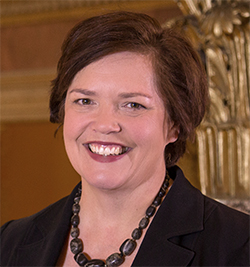
Commissioner Margaret Anderson Kelliher |
2020 is a year that we’ll never forget. There are any number of cliched ways to talk about last year – but what we all know is that it was unlike anything we could’ve predicted and challenged us in all so many ways. “Hindsight is 2020” has a new meaning these days, doesn’t it?
Like many of you, I’m more than happy that we’ve put 2020 in our rearview mirror. But a new year doesn’t mean the challenges of last year are over. Of course, we all know that the COVID-19 pandemic is still very real and claiming lives every day. As of this writing, more than 6,000 Minnesotans and nearly 400,000 Americans have died from COVID-19. Even as we look to a brighter future in the months ahead, may we never forget those hundreds of thousands of lives – and millions more around the world – who we’ve lost this deadly pandemic.
And before I go any further, I just want to say thank you. I am so grateful for, and deeply impressed by, the resilience and commitment that you all have shown as MnDOT employees and public servants. Despite revenue impacts, enhanced safety protocols and changing work conditions for those still reporting to their work locations, working from home and much more, we have asked a lot of you over the last year and I know it hasn’t been easy. I am so proud of the way this agency has come together to support each other and continue serving the people of Minnesota. Thank you all!
This is a pivotal time for all of us in state government, and I’m excited about the opportunities in the year ahead for MnDOT. Just a few of the things I’m looking forward to:
- Hearing from MnDOT employees at virtual townhalls and other events. As many of you know, we’ve begun hosting virtual townhalls with the districts – if yours hasn’t been scheduled yet, stay tuned! It’s been wonderful to hear from employees and, while I’d prefer the opportunity to meet in person, I appreciate how many folks have joined us so far (thanks to those in District 3 and District 4!) and look forward to many wonderful future conversations.
- Working with our new Deputy Commissioner Kim Collins. Kim has been an exceptional leader at this agency, most recently as the Director of the Office of Civil Rights. Her passion and professional experience uniquely qualify her to be our next Deputy Commissioner, and I’m thrilled to work alongside her in this new role.
- Updating our mission, vision and business planning process. 2020 also brough with it an important reckoning and acknowledgement of racial justice and inequalities. I’m proud that we’ve embarked on a process to ensure that our agency’s guiding documents embody our values, our commitments to the people we service, and our focus on ensuring a safe and supportive environment at MnDOT for all employees.
- COVID vaccinations. It will take time for all of us to have the opportunity to receive a COVID vaccine, and the state continues to prioritize high risk populations with the limited doses currently available. As the year goes on, more of us will have the opportunity to get vaccinated – a critical step in returning to many of the pre-pandemic activities we all miss and enjoy. We will continue to provide you with updated information about vaccines as it becomes available.
- Spending time outside. From skiing, running and walks outside in the many wonderful parks our state has to offer, I’m looking forward to continuing to spend as much time as possible outdoors and enjoying Minnesota’s beautiful natural resources.
|
| |
|
| |
|



